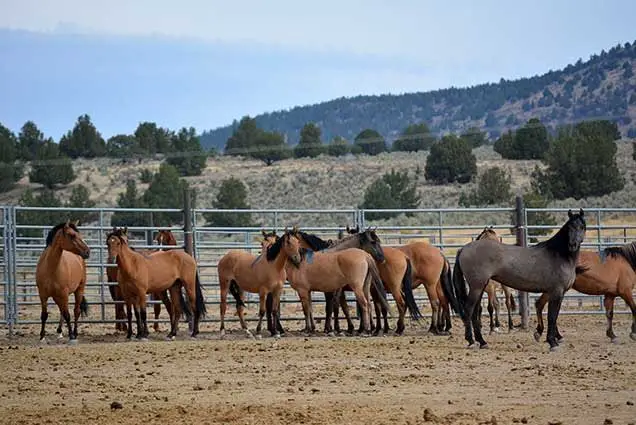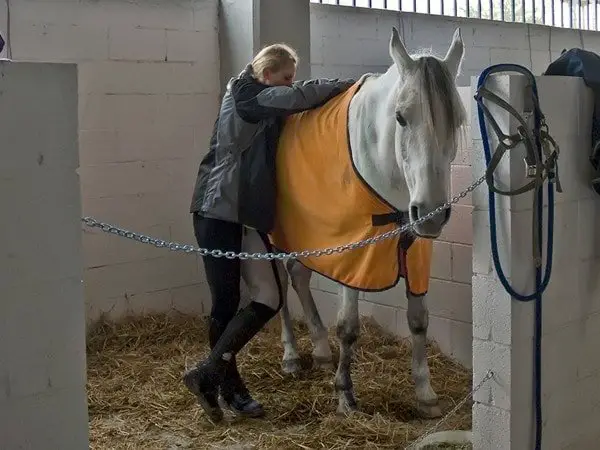Equine Herpesvirus-1 (EHV-1) infection is one of the most important viral diseases in horses of all age groups. EHV-1 is primarily responsible for respiratory disease. The virus transmitted to other organs and develops many other diseases like abortion in pregnant mares, death of young foals, neurologic disorders in adult horses, and equine herpesviral myeloencephalopathy (EHM).
Important Information on EHV-1
Equine herpes virus is a double-stranded DNA virus that is found all over the world and affects mainly horses. The virus affects all ages of horses throughout the year and mainly occurs in autumn and winter. The virus is spread rapidly to the horse population and transmit via air up to 5 meters. The horses affected by EHV-1 can develop neurologic signs and neonatal death of foals. In my article, I shall highlight the essential information on this devastating viral disease of horses.

Causes of EHV-1 Infection
Equine Herpesvirus is a DNA virus under the family Herpesviridae. There are nine different strains of this virus from EHV-1, 2, 3, 4, 5, 6, 7, 8, and 9. All strains are not equally pathogenic.
EHV-1 causes severe respiratory disease, abortion, neurological disorders, and neonatal death.
EHV-3 causes venereal diseases, especially in female horses like coital exanthema, that do not affect the mare’s fertility.
EHV-4 causes upper respiratory diseases in horses that are not very serious, not associated with neurologic diseases, and rarely abortion in pregnant mares.EHV-4 is associated with Equine Influenza.
Rist Factors of Equine Herpesvirus Infection
The risk factors of EHV-1 are:
- Age of Horse: Older horses are at more risk of this disease.
- Confined versus pastured horse: Confined horses at the stable are at more stressed and high risk to EHV-1 than pastured horses.
- Increased traffic of people and horses in the stable.
- Use of standard equipment and utensils.
- Gender of horses (male or female).
- Training of horses and competitions.
- Season of the year: winter and spring.
Transmission of Equine Herpesvirus-1 (EHV-1)
EHV can be survived in the environment for seven days at an average temperature. If the environment is favorable for the viruses, they can survive up to 30 days in the stable and associated areas.

The virus is mainly transmitted and spread via direct contact with the nasal droppings of the affected horses. However, the virus can also be spread to healthy animals by indirect contact with sound equipment, caregivers, and veterinarians. The virus can also be spread via air at a certain distance. The methods of transmission of the virus are:
- Contaminated human hands and clothing.
- Contaminated stable equipment and utensils.
- Contaminated horse transportation trailers.
- Grooming equipment contaminated with EHV.
- Feed and water bucket contaminated from sick horses.
Clinical Signs of EHV-1 Infection
The disease’s incubation period usually is 4-6 days but may be as short as 24 hours. The typical clinical signs are:
- Biphasic fever may arise on day 1 or 2 and again reach six or 7th days.
- In respiratory infection, serous or mucoid nasal discharge with lack of coughings.
- Persistent enlargement of submandibular lymph nodes.
- In neurologic form, there are minimum respiratory signs, but fever may reach up to 105°F.
- Incoordination.
- Weakness of hind limbs.
- Loss of tail tones.
- Lethargy.
- Dribbling of urine.
- Tilt head.
- Leaning against the fences or wall to maintain balance.
- Unable to rise or stand up.
- Horses often sit in a dog sitting position.
- The reproductive form of EHV-1 causes abortion in pregnant mares.
- Neonatal death or stillbirth.
Diagnosis of Equine Herpesvirus-1
The history makes the presumptive diagnosis of the disease of contamination and clinical signs. The confirmatory diagnosis can be made by:
- Collection of samples from nasal swabs, isolation of the virus, and detection by qualitative polymerase chain reaction (qPCR).
- Collection of blood from the affected animals and detection of virus by qPCR.
- Blood samples should be collected 2-4 days apart to get the antibiotic assay.

Treatment of EHV-1 Infection
The disease is a viral disease, and there is no specific treatment for this disease. The palliative treatment for EHV-1 included:
- Intravenous fluid therapy.
- Non-steroid anti-inflammatory drugs (NSAID).
- Broad-spectrum potential antibiotics to prevent further bacterial infection.
- You can give anti-viral and anticoagulant drugs that will reduce EHM chances (Equine Herpes Myeloencephalopathy).
Prevention and Control of EHV-1 in Horse Population
The most common and effective preventive measures of EHV-1 are vaccination and strict biosecurity measures.
- Isolation of affected animals from healthy animals.
- Quarantine of new horses in the herd for at least four weeks.
- Removal of all debris, dungs from the stable, paddock, and its premises.
- Use potential antiseptics to wash stables and premice.
- The nose-to-nose contact of the horse should be strictly controlled.
- All stables and grooming equipment, feed, and water trough should be adequately disinfected.
Vaccination Against EHV-1
Vaccination is another most potential method of preventing the disease in the horse population. The vaccination induces resistance against the disease and gives durable protection from EHV-1. However, few vaccines available to prevent respiratory diseases and abortion in horses are not giving complete protection against neurologic diseases like EVM. Therefore, foals should be vaccinated at the age of 3-4 months, and three consecutive doses of vaccine should be given at 3-4 weeks intervals.
Concluding Remarks on Equine Herpesvirus Infection
EHV-1 is one of the most common and devastating diseases of all age grouped horses. The virus causes respiratory infection, abortion, neonatal death, and neurological signs. The disease can be prevented and restrict the entry of the virus to stables by improving hygiene, biosecurity, and mass vaccination. In my article, I have discussed most of the information in brief. You can study further as per your requirement. I think this information will help you a lot.